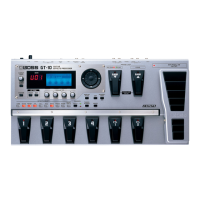12
Using the ASSIGN Screens to Make Detailed Realtime
Control Assignments
On the ASSIGN screens, you can have some
real fun creating sophisticated realtime
control assignments. This is where you
make settings for all the GT-10’s realtime
controllers: the onboard foot switches and
pedal, the wave and internal pedals, input
level, external foot switches, an external
pedal, and MIDI.
There are eight different ASSIGN screens (ASSIGN 1-8), allowing you to make
eight different realtime control assignments. Additionally, you can specify
how the realtime controllers behave. Here are just a few examples of things
you can do on the ASSIGN screens:
Assign a single foot switch to turn multiple different effects on/off with a
•
single press
Assign a foot switch to toggle between two different parameter values in a
•
single effect (or many effects)
Assign an effect (or multiple effects) to turn on/off only when a foot switch
•
is pressed and held
Continuously control any effects parameter (or multiple parameters) with
•
the onboard expression pedal or an expression pedal
Assign a foot switch to the internal pedal and vary an effects parameter
•
over time when the foot switch is pressed
Have an effects parameter vary continuously with the wave pedal
•
Assign a parameter to be adjusted by varying your picking dynamics •
Assign parameters to respond to incoming MIDI CC messages•
Using the ASSIGN screens, you can control your GT-10 effects to an
unprecedented degree, giving you an amazing amount of expressive control
over your guitar tone.
Any realtime control assignments you make on the ASSIGN screens are
in addition to the controls assignments made in the previous section,
“Quickly Assigning Common Functions to Realtime Controllers.”
ASSIGN Screen Functions
The following table shows all the available functions in the ASSIGN screens.
Function Label What It Does
Primary
Target
Target This determines the effect or function you
want to control.
Secondary
Target
None This determines which of the primary
target’s parameters is to be controlled.
Minimum
Value
Min This sets the minimum value for the
secondary target.
Maximum
Value
Max This sets the maximum value for the
secondary target.
Control
Source
Source This determines the GT-10 realtime
controller that will control the target.
Control
Source
Mode
Src Mode This determines how the source controller
behaves (momentary or toggle). This
setting only has an effect when a foot
switch is selected as the control source.
Active
Range
Low
ActRngLo This sets a secondary minimum value for
the secondary target, based on the current
“Min” setting. (Normally, you’ll want to
leave this set at 0.)
Active
Range
High
ActRngHi This sets a secondary maximum value for
the secondary target, based on the current
“Max” setting. (Normally, you’ll want to
leave this set at 127.)
Internal
Pedal
Trigger
Int Trig When INTERNAL PDL is selected as the
control source, this setting determines
what action or controller initiates the
internal pedal’s assigned parameter
adjustment.
Internal
Pedal
Time
Int Time When INTERNAL PDL is selected as the
control source, this setting determines
the speed of the internal pedal’s assigned
parameter adjustment.

